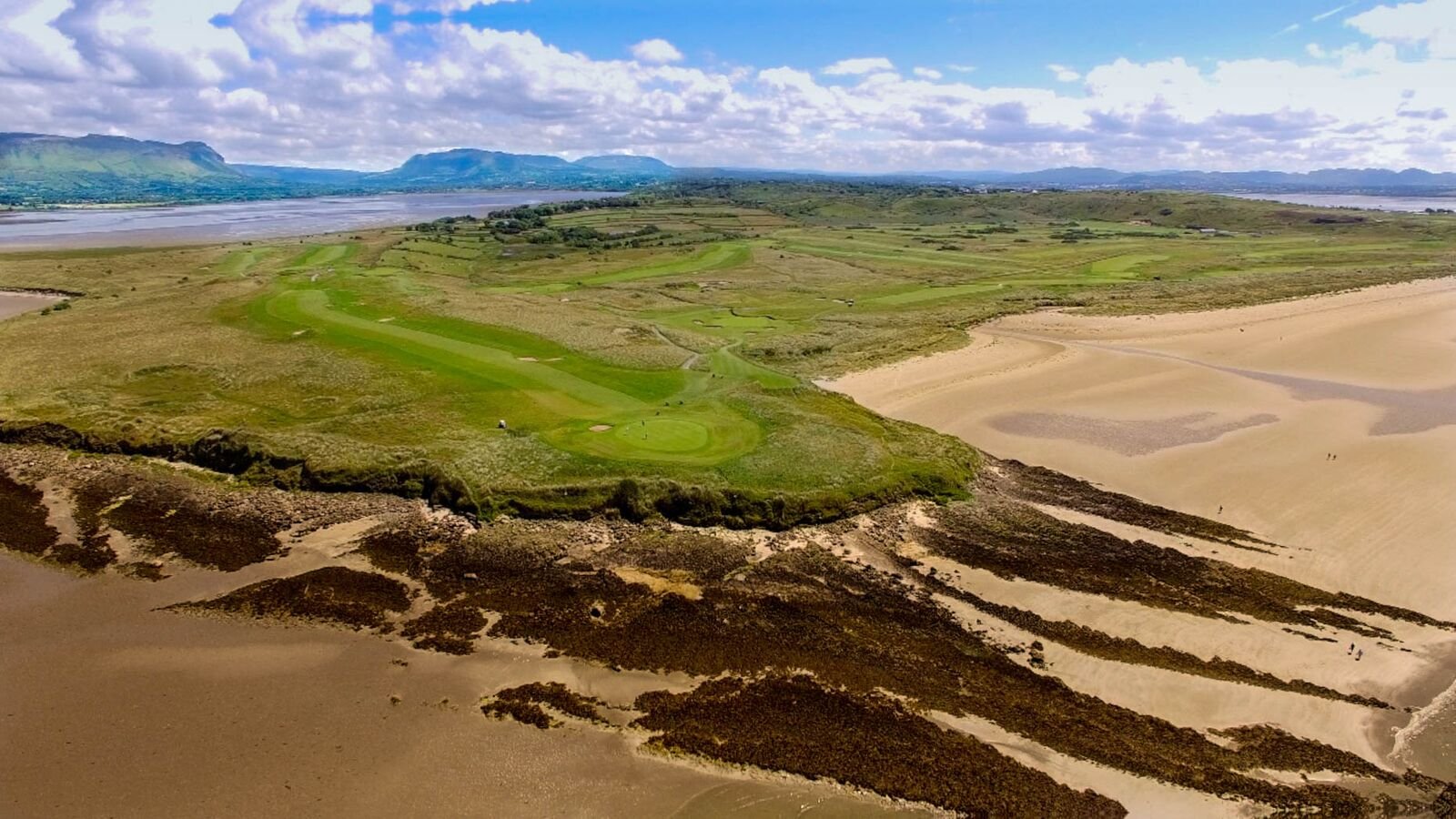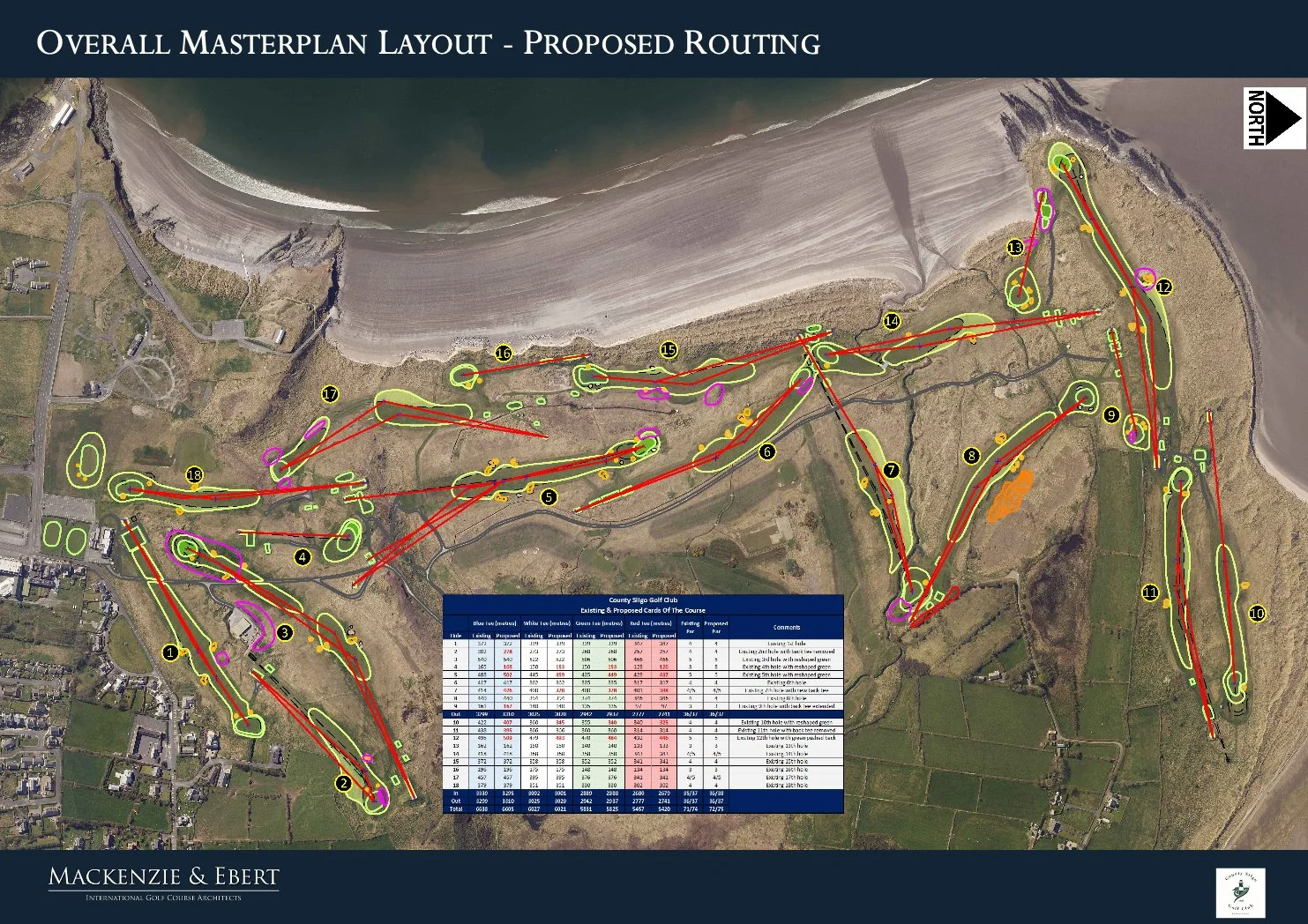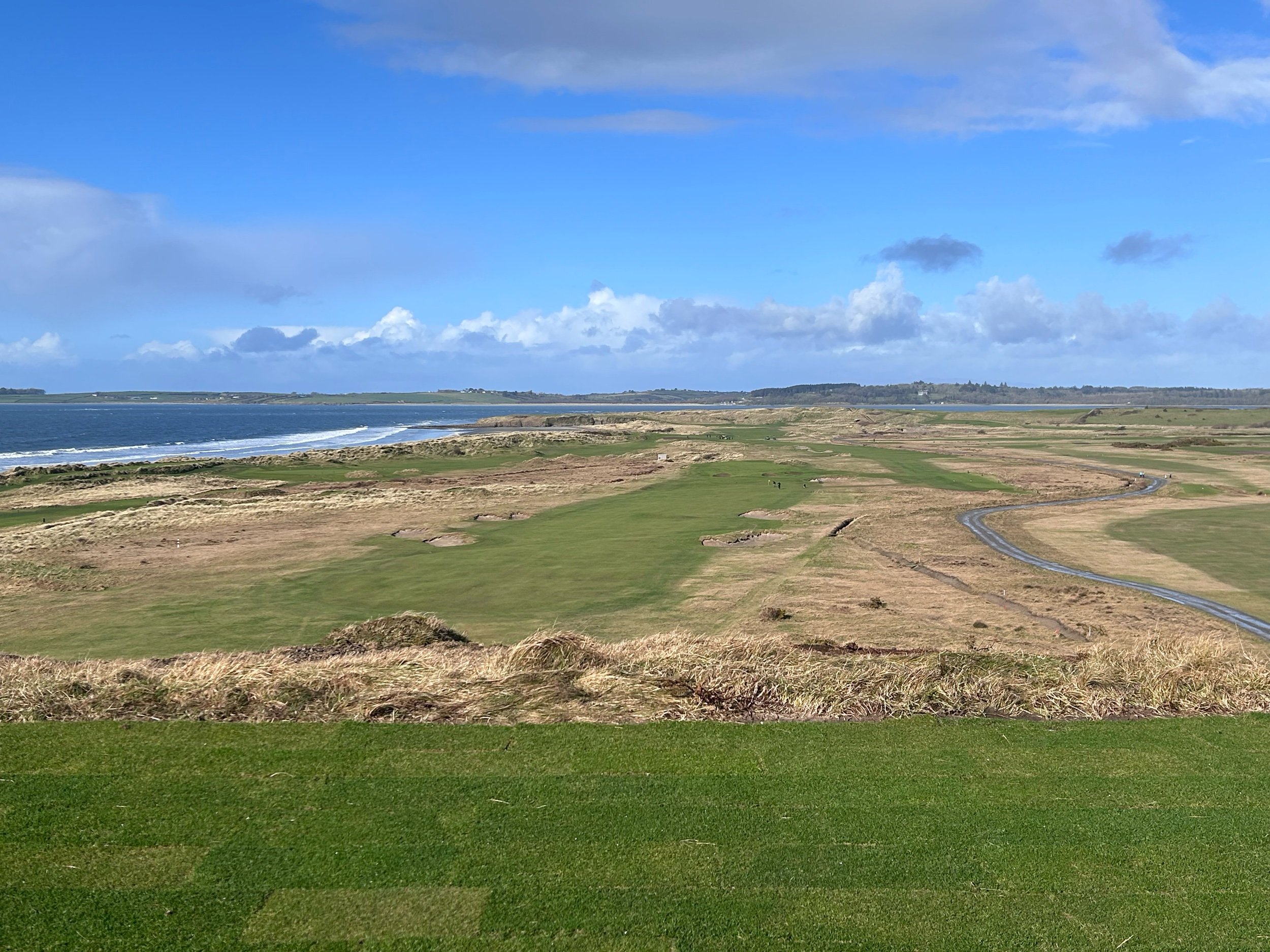County Sligo members approve Mackenzie and Ebert masterplan
County Sligo will host the 101st Connolly Motor Group-sponsored West of Ireland Championship this week, but players returning over the next five years will find the course gradually transformed after the club unanimously approved a massive course development plan this week.
Around 135 members attended a presentation by Martin Ebert from Mackenzie & Ebert at Monday’s Special General Meeting and there was 100pc approval of a plan which proposes 84 changes that will make the famous Rosses Point links a more playable but no less challenging test.
“There was not one naysayer, which is incredible,” said former Ireland international David Dunne, the club’s liaison on the project.
He’s excited about a project which will see the majority of the tasks, many of which involve the refinement of run-offs and slopes and the widening of fairways, carried out by the greenkeeping staff with contractors appointed to do bigger project elements.
The masterplan aims to improve individual holes and the course in general, explicitly emphasising a consistent approach to bunkering on the Harry Colt-designed course.
There are currently as many as five styles of bunkers, but under the approved plan, there will be just two: revetted greenside bunkers and rough-edged fairway bunkers. Mackenzie and Ebert used this strategy to great effect in their renovation of Turnberry.
The overall length of the championship course will be reduced by 33 metres to 6,605 metres (7,223 yards), and the number of bunkers will be reduced from 84 to 71, with 31 removed and 18 added.
“The relatively recent changes to the course have led to improvements in some areas,” reported the architects, who are also the official architects to the R&A, having transformed Royal Portrush for The Open in 2019 and Royal Liverpool last year.
“However, it is debatable as to whether the end result of other adjustments has improved the individual holes and whether those changes conform to the original Colt-inspired features.
“For instance, the three huge greens at the 3rd, 5th and 10th which have been created seem to sit at odds with the character of the rest of the greens on the course.”
All three greens will be changed with a new green complex for the third and the fifth and 10th return to their original footprint.
There is also a contingency plan to build a new par-three in the event the 16th has to be closed due to the threat of erosion.
The proposal is to build a new 185-metre hole (11th) of equal stature behind the current 10th green, heading east along the shore of Drumcliff Bay, offering enhanced views of Ben Bulben.
“Apart from this major potential project, the rest of the proposals will refine what is already a great example of a links course,” Ebert and Mackenzie said.
Some of the more eye-catching changes include a realignment of the seventh to the left to offer another angle to the green and moving the 12th green closer to the water’s edge,
Work will commence at the end of this season.
“We will start once the last green fee is gone,” Mr Dunne reported. “Probably in October.”
County Sligo has experienced a boom in green fee income since COVID-19 and with overseas visitors set to flock to the links over the next few years, the funds are there to enhance an already special test.
As for the West of Ireland Championship, there is an 18-hole qualifier on Wednesday with 17 spots up for grabs in strokeplay qualifying on Friday and Saturday where the top 64 after 36 holes will make the matchplay draw for Sunday.
The final is scheduled for Tuesday afternoon.
Comments and specific recommendations
1st hole
1. Remove the back left teeing area as it is not necessary to have two back tees.
2. Move the fairway bunker on the right towards the tee so that more of the landing area is covered by
the three bunkers.
3. Reshape the fairway bunkers, making them larger and with a rough-edged style.
4. Lower the artificial mound behind the left fairway bunker to tie in more naturally with its surrounds.
5. There is a possibility to mow the green out at the front left and to the rear left.
2nd
1. Remove the back tee as this should be a hole where more elite level players try to take the hole on.
2. Remove the right fairway bunker as the wall should be the hazard to the right of the hole.
3. The face of the artificially revetted bunker is really too steep. It should be replaced by a rough-edged bunker with a high sand face to the left edge to help with visibility from the tee.
4. Mow the fairway and approach out to the right up to the wall to bring this into play giving more options for playing the hole.
5. Regrade the green surrounds to the left to provide more variation to the shapes and to make the bank easier to maintain.
6. It was reported that the soft ridge along the left edge of the green has been removed so it would be good to reinstate this.
3rd
1. Lower the white tee by 0.5m to give a better view of the fairway from the back tee.
2. Replace the 3 fairway bunkers on the right with a new bunker in the area set into an existing mound.
3. Create a dune structure to block the view of the maintenance area.
4. An issue has been raised about the possible rerouting of the road across the fairway to avoid balls bouncing off it and to improve the aesthetics of the hole. The only sensible rerouting would bring the road much closer to the tees underneath the split in level of the hole. That would be a very long and expensive diversion and getting it back to the road along the right of the 4th would require an awkward and tight curve.
5. Reshape the mounds on both sides of the approach to make them look more natural., introducing another rough edged approach bunker in the left semi-rough to create a triangle of hazards with the two right approach bunkers.
6. Remove the 3 greenside bunkers and add a new bunker to the front left of the proposed green.
7. Reduce the size of the green, reshaping the surface and surrounds.
4th
1. Reduce the steep slope of the run off to the right of the green so that it can be cut tightly but it should remain as steep as possible.
2. Very subtle adjustments of levels to the right side of the green could be considered to produce slightly flatter areas for the flag but the levels are not far from being acceptable as they are.
3. The shape of the rear left green surrounds should be soft enough that the green could be mowed out to create more pin positions on a dramatic green. If it becomes apparent after the green is mowed wider that the area is still too sloping for possible pin locations, the area could be slightly raised and regraded to create more pin positions, adding more variety to the hole.
5th
1. Add a new tee to the right of the 4th green on a similar line to the right hand back tee to provide a more interesting angle for the tee shot.
2. Re-bunker the landing area to break up the regimented line of bunkers down both sides of the fairway.
3. Convert the right hand approach bunker to a rough edged bunker, raising the sand line and restoring the size of the bunker.
4. Remove the right hand greenside bunker and push it further on, to the front right of the proposed green.
5. Reshape the left greenside bunker.
6. Remove the back right greenside bunker and extend out the tightly mown green surrounds.
7. Reshape the green and approach, occupying the rear section of the huge surface with the green and making it around half of the current size. The unusual mounding at the back left of the green is to be reshaped.
6th
1. The left fairway bunkers are a strong visual feature of this hole with how they flash up from one another from the view from the tee. This could be enhanced by extending the furthest fairway bunker
left, increasing the height of the sand line by following the shape of the existing contours.
2. Restore the historic bunker in the hollow just beyond the furthest existing fairway bunker.
3. Regrade the swale to the right of the green, making it deeper and wider, if drainage allows.
7th
1. Add a new back tee on the ledge in front of the 15th tee as golfers already wait for each other.
2. Lower and reduce the size of the tee between the 6th and 14th greens to make it part of the green surrounds between the two greens.
3. Add a new forward tee.
4. Mow the fairway out to the stream running to the left of the hole, providing more options for how to approach the hole. Players can choose the straighter, shorter route which will bring the enlarged fairway bunkers into play and a tighter line into the green. Alternatively, playing further left will lengthen the hole, but reduce the risk of finding a bunker and provide a wider line into the green.
5. Reshape the two right fairway bunkers to become rough edged bunkers.
6. The current left fairway bunker will become a centre line bunker with the widened fairway. This will be slightly reduced in size so it isn’t quite as imposing of a hazard.
7. Remove the back left greenside bunker.
8. Mow out the green surrounds at the rear, raising the lowest point of the swale.
9. Regrade the area to the back right of the green removing all of the material which was imported when the green was extended in this direction.
8th
1. The trees and brambles to the right of the tee should be cleared.
2. Introduce a bare sand area, making the lower ground to the right of the hole a real feature. This could also be a source of sand for other elements of the project.
3. The fairway could be mowed wider to the right in the landing area, running along the existing ridge.
4. The high sand line of the tongue of the fairway bunker is an unusual, artificial feature. To retain the visibility of the bunker from the tee, the bunker should be enlarged and rough edged, becoming a real feature of the hole.
5. It is recommended that all three greenside bunkers are removed. The expansive green surrounds could benefit from being reshaped without the bunkers detracting from this feature.
9th
1. Extend the back tee at the back to extend the hole and to gain valuable teeing area on a par 3.
2. The dominant artificially revetted bunker has a face that is a little too steep which is likely to have led
to the use of artificial revetting receiving a bad reception from the members.
3. Lift up the back right of the green to make it harder for balls to run off the green.
10th
Comments & Specific Recommendations
1. Restore the green to its old size as the run off to the front left is a good feature and the extended green is just too long.
11th
1. Remove the back tee which is so small and hardly ever used.
2. Mow out the fairway 5m to the right where it feels it ought to be but maintain a semi rough band to avoid balls running down the bank into the deeper rough.
3. Mow out the fairway in the approach to the left and push the left greenside bunker further on and left where there looks to have been an old bunker. That will provide a wider approach where it is possible to land the ball short and run it onto the green.
4. The recently added bunker to the front right of the green should be retained as it does remove the problem of the divoting that used to occur in the area.
5. The green could be mowed out further to the rear.
12th
1. Keep the right hand tee, but the one on the top is the preferred tee to play the hole. The margin between the line of play and the 9th tees is quite reasonable and visibility between the two tees is perfect in case any errant tee shots head in that direction.
2. Mow out the fairway to the right as the camber on the fairway is strong and so many balls end up in that area of rough.
3. Because of the widened fairway line, the existing bunker will be moved slightly further on and to the right, as well as being enlarged and rough edged.
4. Remove the current greenside bunker if the green is pushed back.
5. While the relatively new green has some good surface and surround shapes, the opportunity to move the green back to bring it closer to the cliff edge is appealing. The one concern could be the exposed nature of the location but a good green design should mean that this would not cause any issues. It may come with challenges, but the green position would be a marvellous addition to County Sligo. The new green would be protected by a front right and back left bunker.
13th
1. Reshape the teeing area and split the large area up into three sections at different levels. The back section can be raised by 0.75m and the front section lowered by around 0.50m (subject to rock not being encountered) to ensure a good view of the green from all points on the tees.
2. The vegetation can be removed and the ridge lowered in the carry to make the view of the green even better from the tees. The vegetation could be replaced once the ridge is lowered if it is valuable.
14th
1. Mow the fairway back towards the tees to make the hole more playable when the wind is against.
2. Reshape the fairway bunker on the left, edging it to the right but not as far as the old bunker which looks as though it must have been a feature years ago. The fairway would wrap around it and the best line to the green would be achieved by carrying the bunker to reach the left half of the fairway.
3. Remove the existing bridge and replace with a more aesthetic stone bridge.
15th
1. Increase the size of the right-hand tee so that it can take more play as the view is so good from its surface.
2. Regrade the mound to the left of the fairway to produce a more natural-looking feature.
3. Mow out the fairway to the right as it looks rather strange as a large area of semi-rough.
4. Regrade the mounding in the surrounds of the two fairway bunkers.
5. Remove the bunker to the right of the fairway and mow the fairway out to the base of the dunes.
6. Remove the two left greenside bunkers and the rough mounding behind them. This allows for a wider, tightly mown green surround, which can offer interesting shape and a variety of recovery shots from the run-off area.
16th
1. The tees may be affected by erosion in the future.
2. The prominent mound to the left of the green could be reshaped.
3. The steep bank of the green surrounds is a good feature but it is rather uniform in shape and would be better to be given more variation of angle.
17th
1. Mow out the fairway to the right to provide more variation in line and length for the tee shot. The view up the 2nd part of the hole is better the further right the ball is played from.
2. Mow the 2nd half of the fairway back towards the tee and regrade the ridge which is in the area.
3. Regrade the area to the right of the green which has been built up to make it look more natural.
4. Regrade the mound to the left of the green as it is very steep and unnatural. It must have been formed quite crudely when the green was first built.
18th
1. Improve the levels of the right-hand teeing area and remove the lush vegetation to the right of it.
2. The causeway to the fairway is very stark in the landscape. Consideration should be given to realigning it over a more circuitous route around the valley or replacing the hard pathway with a more aesthetic, comfortable and natural looking material.
3. Widen the fairway lines where it feeds into the two new fairway bunkers.
4. Add two staggered, rough-edged fairway bunkers on either side of the fairway.
5. Remove the bunker to the right of the approach and set the other bunker more into the mound, slightly larger than its current size.
6. Remove the bunker at the back right of the green.
7. With the bunker removed, extend the green out further to the right as it is a little too narrow where the extension has been added.
NEW 11th?
1. There is the opportunity to introduce a new par 3 between the current 10th and 11th holes to replace the 16th if it is lost due to erosion and the routing of the coastal footpath.
2. The tees would be set up at the level of the dune ridge to give great views of Drumcliff Bay and beyond towards Benbulben Mountain.
3. The green would have similar views as it would also be perched up in level set out of the dune ridge.








